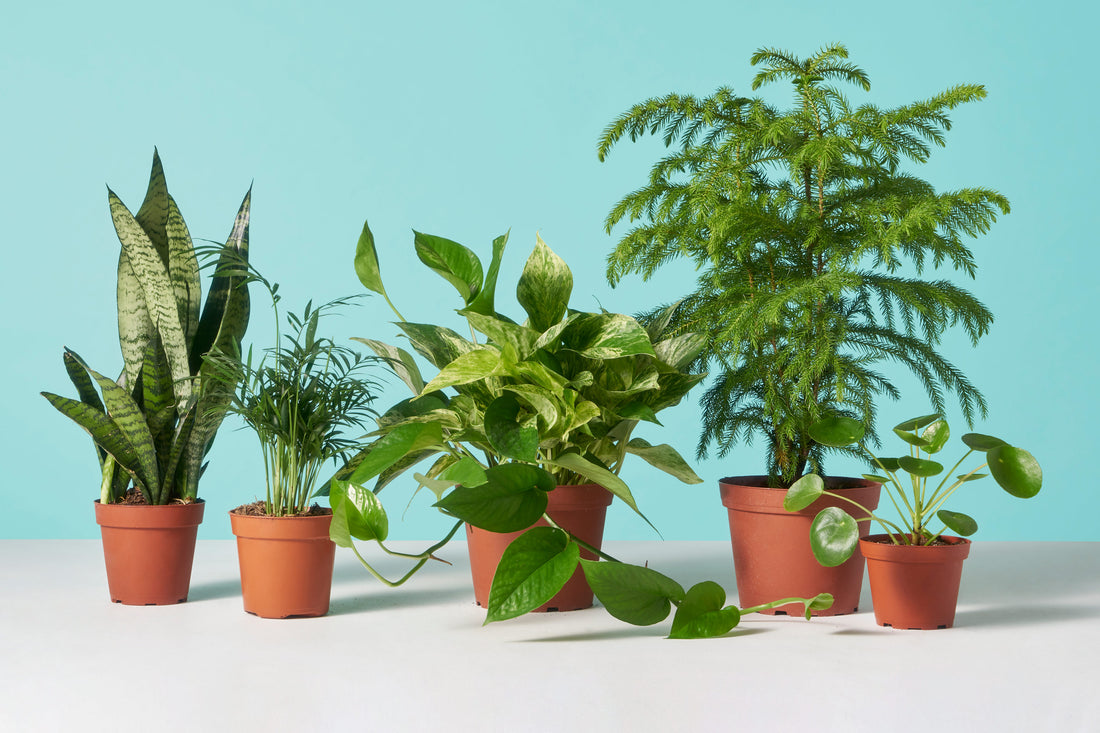
Plants 101
Our Top Low-Maintenance Houseplants for Under $20

Not only can indoor plants transform a room’s aesthetic, but they also have the ability to boost mood, increase creativity, lessen stress, and filter out indoor air toxins. These are all great reasons to invest in plants for your home. Plus, our low-maintenance favorites below are all under $20. Now that’s a win-win!
(1) Snake Plant for beside the bed
A plant that produces oxygen while you snooze.
The snake plant is a no-fuss tropical plant that has thin, upright leaves with irregular banding resembling reptile skin. Often positioned as a low light, or even no light, plant — snake plants actually prefer medium to bright light but can tolerate very low light levels like no other. They won’t actively thrive in super low light levels, but they’ll survive! This adaptation, along with their succulent nature, makes for an almost indestructible houseplant.
Surprised that snake plants are considered succulents? Like other succulent plants, snakes have a modified form of photosynthesis. In order to preserve water, they open their pores exclusively at night. But since photosynthesis only happens with daylight — the plant stores carbon dioxide absorbed at night for use during the day, and releases oxygen at night when its pores open. This helps it maximize efficiency in cleaning the air. In a study conducted by NASA, snake plants were found to filter out various toxins such as benzene, formaldehyde, trichloroethylene, xylene and toluene.
(2) Air Plants for the shower sill
A plant that creates instant spa-shower vibes.
Tillandsia is a genus of neotropical epiphytic plants that belong under the bromeliad family. They are referred to as ‘air plants’ because of their ability to grow without any soil. In their native environment, they can be found growing on top of tree branches, cliffs, and even telephone wires! They have evolved to pull in water from the frequent rain showers in these places through their fuzzy trichomes.
In your home, air plants make the perfect houseplant for a bathroom that receives plenty of natural light. The running water from your bathroom sink and shower helps increase humidity levels, which mimic air plants’ native environments. Just another reason to enjoy a long, warm shower.
(3) Rubber Tree for the family room
A plant that makes burgundy the new black.
The rubber tree is known for its glossy burgundy leaves. It only looks like it would be hard to care for. It does well in medium indirect light to dappled sun along with weekly waterings when the potting mix is completely dry.
Ficus elastica, a member of the fig family Moraceae, gets its common name because its latex sap was once used to make rubber (before synthetics and other natural alternatives became available). Its sap can be considered toxic, and although not fatal, we recommend keeping it out of reach of small children and pets. You wouldn’t want to come home to a sap-covered couch.
(4) Aloe vera Plant for the kitchen windowsill
A plant that is a natural extension of your medicine cabinet.
Although there are over 300 species of aloe, it is the Aloe vera that is used most often for medicinal purposes. The ancient Egyptians and Mesopotamians kept extensive records of its use — even referencing it in the Book of the Dead as part of the skin-preservation process during mummification! Nowadays, we use aloe to soothe irritated skin, heal minor burns, reduce itch, and more. Simply cut off a large, mature leaf, squeeze out the gooey insides, and apply directly to your skin.
Recent studies have shown that the aloe has an additional benefit — it filters the toxins benzene and formaldehyde from indoor air — making it the perfect plant pick for the hub of your home. Place your aloe on a warm, sunny sill, and water only when dry. Aloes are drought-tolerant and prefer to be under-watered. Not sure when to water? Wrinkles on the aloe’s fleshy leaves are a telltale sign.
(5) Pothos for the home office
A hardy houseplant that doesn’t require extra work.
The pothos is a vigorous grower that is known for its long, trailing vines. In its natural habitat these vines both climb up neighboring trees, thanks to their aerial roots, and stretch across the forest ground, thanks to their trailing stems. You could think of the pothos as a tropical weed! In fact, in some places they are thought to be an invasive species because of their hardiness and rapid growth.
But the pothos easy-to-grow nature makes for a wonderful houseplant. It requires little care and can handle minimal sunlight, yet is attractively fully and leafy. In fact, it is fondly nicknamed the ‘cubicle plant’. Wonderfully versatile, the pothos can be grown both in soil and water. And is an easy plant to propagate. Studies have show it is also efficient in removing pollutants such as formaldehyde, xylene, and benzene from indoor air. Breathe easy while you work.

Words By The Sill
Empowering all people to be plant people—a collection of articles from The Sill's team of plant experts across a variety of plant care topics to inspire confidence in the next generation of plant parents. Welcome to Plant Parenthood™.
Do Some Plant Shopping
